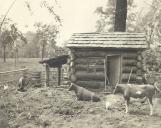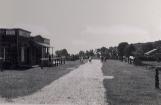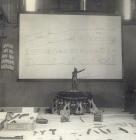1
Amos' model of pioneer lifecirca 1931
Lobo Township, Middlesex County, Ontario, Canada
 Credits:
Credits:Museum of Ontario Archaeology
2
For many years both Wilf and Elsie had envisioned a "Pioneer Village" as an educational facility to preserve local heritage. Some of Elsie's published articles from the 1940s anticipated the day when such a facility would be built, and Wilf was sitting on a goldmine of information and relics. He had the actual artifacts used by the hands of his grandfather and great-grandfather, access to Alder's weaving shop, the provisions stockpiled from the old Melrose General Store and many fine memories of how things were made and used "the old-fashioned way".4
In 1955-1956 the dreams became a reality when the newly established Upper Thames River Conservation Authority announced plans to create Fanshawe Conservation Area on lands surrounding a new dam. Land was set aside for the development of a pioneer village to be conceived and supervised by Wilf but operated by the Conservation Authority in a unique partnership with the University of Western Ontario.5
Amos's models of pioneer lifecirca 1931
Lobo Township, Middlesex County, Ontario, Canada
 Credits:
Credits:Museum of Ontario Archaeology
6
Wilf and Elsie somehow found the time to coordinate the efforts for volunteers to assemble the buildings and furnishings. The official opening of the village took place in June 26, 1959. "The day the village opened, the dream of years had started for me. It meant more to me I am sure than anyone else. Not only my hopes became a reality, but (the village was) near home in the district that the equipment had been used - the old hand tools polished by the hands of our forefathers, in such a manner that his story shall become our local history lesson,reminders of the sweat and toil the pioneers gave for our Country. I may be too sentimental about the past - its been my life's work to give the lession of the past in a visual way, preseve the evidence and let the old junk, the relics, come alive, telling their own story" (Wilfrid Jury, 1972 autobiography).8
Wilf continued to oversee the operation and continued expansion of the village into the 1970s. He even arranged in 1973 to move the Jury house, complete with some original furnishings including some of Amos' paintings, from Lobo Township to the village. The newspapers, especially the London Free Press, ran frequent articles about the constant improvements to and Wilf's role at the village. An April 23, 1977 item mentions that for the twenty-first year he was again getting the place "ship-shape for the opening of the season on May 24". A few years prior to that a Free Press article had noted that Wilf had expressed his hope that when he died he wanted "to see Fanshawe as my monument". The village carries on today with special events and educational programs greatly expanded from the days when Wilf was overseeing it, but it is yet another significant Jury legacy.9
Opening of Fanshawe Pioneer Villagecirca 1959
London, Ontario, Canada
 Credits:
Credits:Museum of Ontario Archaeology

